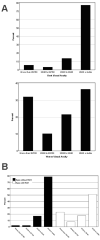Clinical characterization of retinal capillary hemangioblastomas in a large population of patients with von Hippel-Lindau disease
- PMID: 17543389
- PMCID: PMC3026779
- DOI: 10.1016/j.ophtha.2007.03.009
Clinical characterization of retinal capillary hemangioblastomas in a large population of patients with von Hippel-Lindau disease
Abstract
Objective: To report the epidemiology and ocular phenotype of retinal capillary hemangioblastomas associated with von Hippel-Lindau (VHL) disease in a large cohort of patients and to correlate patient and ocular characteristics to visual morbidity in this population.
Design: Cross-sectional study.
Participants: In 220 unrelated pedigrees, 335 patients affected with VHL disease and retinal capillary hemangioblastomas (RCHs) in at least 1 eye.
Methods: Demographics of the patient population were recorded and the ocular phenotype of each patient was obtained with a comprehensive ocular examination.
Main outcome measures: The patient population was characterized and the ocular phenotype described in relationship to tumor location, number, and extent of retinal involvement. Correlations between patient demographics, ocular phenotype, and visual function were analyzed.
Results: We detected RCHs unilaterally in 42.1% and bilaterally in 57.9% of patients. No correlation was detected between the age, gender, or laterality of involvement. Of involved eyes, 86.6% had tumors that could be individually visualized; of these, tumors were commonly found in the peripheral retina (84.7%) only, and less commonly in the juxtapapillary area (15.3%). The tumor count in the periphery averaged 2.5+/-1.8 per eye, with 25.2% of eyes having >1 quadrant of retinal involvement. Of involved eyes, 13.4% were enucleated or prephthsical; approximately 1 in 5 patients had > or =1 eyes so affected. Severe visual impairment (visual acuity < or =20/160) in affected eyes were more likely to be associated with increasing age, the presence of juxtapapillary lesions, and an increasing number and extent of peripheral lesions.
Conclusions: This large cohort of VHL patients with RCHs has enabled a systematic and quantitative characterization of the demographics, ocular features, and visual function in VHL disease. Clinical correlations between the visual morbidity and ocular features of the disease were also performed, producing measures that can help clinicians to estimate visual prognoses better based on the ocular phenotype of the disease.
Figures





Similar articles
-
Genotype-phenotype correlation in ocular von Hippel-Lindau (VHL) disease: the effect of missense mutation position on ocular VHL phenotype.Invest Ophthalmol Vis Sci. 2010 Sep;51(9):4464-70. doi: 10.1167/iovs.10-5223. Epub 2010 Apr 7. Invest Ophthalmol Vis Sci. 2010. PMID: 20375333 Free PMC article.
-
Longitudinal analysis of retinal hemangioblastomatosis and visual function in ocular von Hippel-Lindau disease.Ophthalmology. 2012 Dec;119(12):2622-30. doi: 10.1016/j.ophtha.2012.06.026. Epub 2012 Aug 17. Ophthalmology. 2012. PMID: 22906772 Free PMC article.
-
Genotype-phenotype correlation in von Hippel-Lindau disease with retinal angiomatosis.Arch Ophthalmol. 2007 Feb;125(2):239-45. doi: 10.1001/archopht.125.2.239. Arch Ophthalmol. 2007. PMID: 17296901 Free PMC article.
-
Von hippel-lindau disease: a genetic and clinical review.Semin Ophthalmol. 2013 Sep-Nov;28(5-6):377-86. doi: 10.3109/08820538.2013.825281. Semin Ophthalmol. 2013. PMID: 24138046 Review.
-
Molecular pathology of eyes with von Hippel-Lindau (VHL) Disease: a review.Retina. 2007 Jan;27(1):1-7. doi: 10.1097/01.iae.0000244659.62202.ee. Retina. 2007. PMID: 17218907 Free PMC article. Review.
Cited by
-
New Prospects on Neuroimaging in Von Hippel Lindau Disease-A Narrative Review.Diagnostics (Basel). 2024 Jan 31;14(3):309. doi: 10.3390/diagnostics14030309. Diagnostics (Basel). 2024. PMID: 38337825 Free PMC article. Review.
-
The Role of VHL in the Development of von Hippel-Lindau Disease and Erythrocytosis.Genes (Basel). 2022 Feb 17;13(2):362. doi: 10.3390/genes13020362. Genes (Basel). 2022. PMID: 35205407 Free PMC article. Review.
-
Treatment of Capillary Hemangioblastoma in Von Hippel-Lindau Disease: Case Report and Online Survey of Treatment Preferences among Experts.Case Rep Ophthalmol. 2020 Jan 10;11(1):37-47. doi: 10.1159/000504430. eCollection 2020 Jan-Apr. Case Rep Ophthalmol. 2020. PMID: 32009936 Free PMC article.
-
Genotype-phenotype correlation in ocular von Hippel-Lindau (VHL) disease: the effect of missense mutation position on ocular VHL phenotype.Invest Ophthalmol Vis Sci. 2010 Sep;51(9):4464-70. doi: 10.1167/iovs.10-5223. Epub 2010 Apr 7. Invest Ophthalmol Vis Sci. 2010. PMID: 20375333 Free PMC article.
-
Multidisciplinary management of patients diagnosed with von Hippel-Lindau disease: A practical review of the literature for clinicians.Asian J Urol. 2022 Oct;9(4):430-442. doi: 10.1016/j.ajur.2022.08.002. Epub 2022 Sep 10. Asian J Urol. 2022. PMID: 36381595 Free PMC article. Review.
References
-
- Lonser RR, Glenn GM, Walther M, et al. von Hippel-Lindau disease. Lancet. 2003;361:2059–67. - PubMed
-
- Singh AD, Shields CL, Shields JA. von Hippel-Lindau disease. Surv Ophthalmol. 2001;46:117–42. - PubMed
-
- Webster AR, Maher ER, Moore AT. Clinical characteristics of ocular angiomatosis in von Hippel-Lindau disease and correlation with germline mutation. Arch Ophthalmol. 1999;117:371–8. - PubMed
-
- Melmon KL, Rosen SW. Lindau’s Disease. Review of the literature and study of a large kindred. Am J Med. 1964;36:595–617. - PubMed
MeSH terms
Grants and funding
LinkOut - more resources
Full Text Sources
Medical

